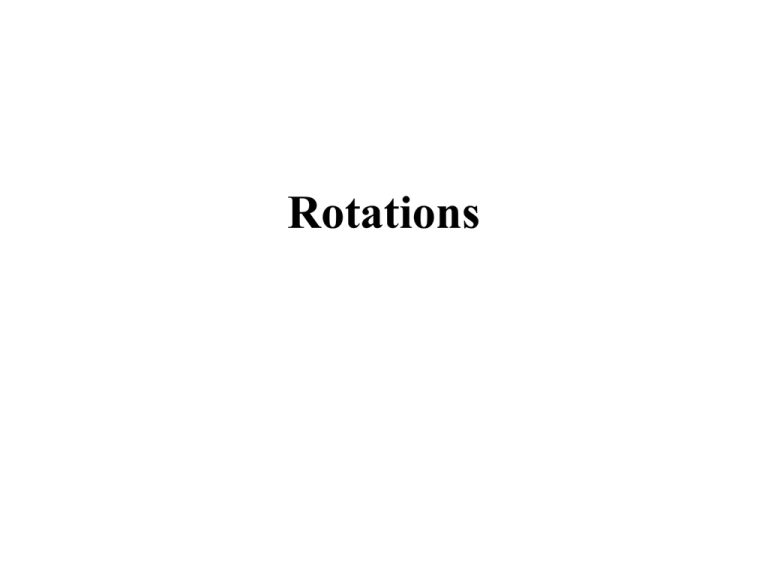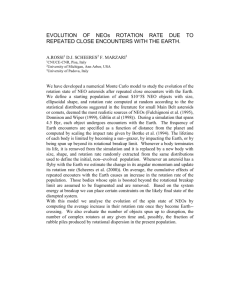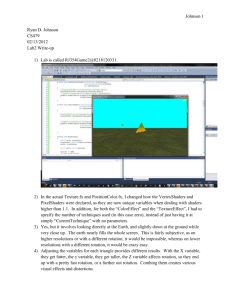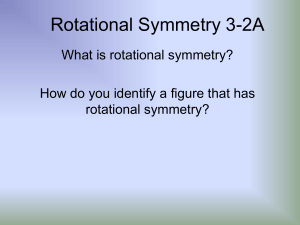Rotational symmetry
advertisement

Rotations Goal • Identify rotations and rotational symmetry. Key Vocabulary • • • • Rotation Center of rotation Angle of rotation Rotational symmetry Rotation Vocabulary • Rotation – transformation that turns every point of a pre-image through a specified angle and direction about a fixed point. image Pre-image rotation fixed point Rotation Vocabulary • Center of rotation – fixed point of the rotation. Center of Rotation Rotation Vocabulary • Angle of rotation – angle between a preimage point and corresponding image point. image Angle of Rotation Pre-image Example: Click the triangle to see rotation Center of Rotation Example 1: Identifying Rotations Tell whether each transformation appears to be a rotation. Explain. A. B. No; the figure appears to be flipped. Yes; the figure appears to be turned around a point. Your Turn: Tell whether each transformation appears to be a rotation. b. a. No, the figure appears to be a translation. Yes, the figure appears to be turned around a point. Rotation Vocabulary • Rotational symmetry – A figure in a plane has rotational symmetry if the figure can be mapped onto itself by a rotation of 180⁰ or less. Has rotational symmetry because it maps onto itself by a rotation of 90⁰. Equilateral Triangle An equilateral triangle has rotational symmetry of order ? Equilateral Triangle An equilateral triangle has rotational symmetry of order ? Equilateral Triangle An equilateral triangle has rotational symmetry of order ? 3 2 1 3 Regular Hexagon A regular hexagon has rotational symmetry of order ? Hexagon Regular Hexagon A regular hexagon has rotational symmetry of order ? Regular Hexagon A regular hexagon has rotational symmetry of order ? 5 6 1 4 3 2 6 Rotational Symmetry When a figure can be rotated less than 360° and the image and pre-image are indistinguishable (regular polygons are a great example). Symmetry Rotational: 120° 90° 60° 45° Example 2 Identify Rotational Symmetry Does the figure have rotational symmetry? If so, describe the rotations that map the figure onto itself. a. Rectangle b. Regular hexagon c. Trapezoid SOLUTION a. Yes. A rectangle can be mapped onto itself by a clockwise or counterclockwise rotation of 180° about its center. Example 2 Identify Rotational Symmetry Regular hexagon b. Yes. A regular hexagon can be mapped onto itself by a clockwise or counterclockwise rotation of 60°, 120°, or 180° about its center. Trapezoid c. No. A trapezoid does not have rotational symmetry. Your Turn: Does the figure have rotational symmetry? If so, describe the rotations that map the figure onto itself. 1. Isosceles trapezoid ANSWER no 2. Parallelogram ANSWER yes; a clockwise or counterclockwise rotation of 180° about its center Your Turn: 3. Regular octagon ANSWER yes; a clockwise or counterclockwise rotation of 45°, 90°, 135°, or 180° about its center Rotation in a Coordinate Plane • For a Rotation, you need; • An angle or degree of turn – Eg 90° or a Quarter Turn – E.g. 180 ° or a Half Turn • A direction – Clockwise – Anticlockwise • A Centre of Rotation – A point around which Object rotates y A Rotation of 90° Counterclockwise about (0,0) (x, y)→(-y, x) 8 7 6 C(3,5) 5 B’(-2,4) 4 C’(-5,3) 3 1 x A(2,1) x A’(-1,2) B(4,2) 2 –7 –6 –5 –4 –3 – 2 –1 -1 -2 -3 -4 -5 -6 1 2 3 4 5 6 7 8 x y A Rotation of 180° about (0,0) (x, y)→(-x, -y) 8 7 6 C(3,5) 5 4 3 B(4,2) 2 1 –5 –4 –3 B’(-4,-2) – 2 –1 x –7 –6 x -1 A’(-2,-1) -2 -3 -4 C’(-3,-5) -5 -6 A(2,1) 1 2 3 4 5 6 7 8 x Rotation in a Coordinate Plane Example 4 Rotations in a Coordinate Plane Sketch the quadrilateral with vertices A(2, –2), B(4, 1), C(5, 1), and D(5, –1). Rotate it 90° counterclockwise about the origin and name the coordinates of the new vertices. SOLUTION Plot the points, as shown in blue. Use a protractor and a ruler to find the rotated vertices. The coordinates of the vertices of the image are A'(2, 2), B'(–1, 4), C'(–1, 5), and D'(1, 5). Checkpoint Rotations in a Coordinate Plane 4. Sketch the triangle with vertices A(0, 0), B(3, 0), and C(3, 4). Rotate ∆ABC 90° counterclockwise about the origin. Name the coordinates of the new vertices A', B', and C'. ANSWER A'(0, 0), B'(0, 3), C'(–4, 3)







